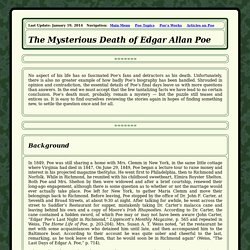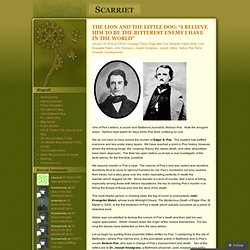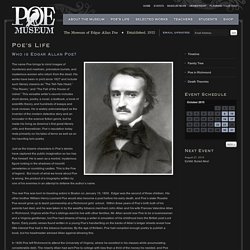

Poe's Mysterious Death. Rabies Theory. Edgar Allan Poe did not die drunk in a gutter in Baltimore but rather had rabies, a new study suggests.

The researcher, Dr. R. Michael Benitez, a cardiologist who practices a block from Poe's grave, says it is true that the writer was seen in a bar on Lombard Street in October 1849, delirious and possibly wearing somebody else's soiled clothes. But Poe was not drunk, said Dr. Benitez, an assistant professor of medicine at the University of Maryland Medical Center.
The writer entered Washington College Hospital comatose, Dr. On his fourth day at the hospital, Poe again grew confused and belligerent, then quieted down and died. That is a classic case of rabies, the doctor said. In the brief period when he was calm and awake, Poe refused alcohol and could drink water only with great difficulty. There is no evidence that a rabid animal had bitten Poe. Poe ''had all the features of encephalitic rabies,'' said Dr. Go Deeper: Rabies Theory. Alcoholism Theory. In 1849, Poe was still sharing a home with Mrs.

Clemm in New York, in the same little cottage where Virginia had died in 1847. On June 29, 1849, Poe began a lecture tour to raise money and interest in his projected magazine theStylus. He went first to Philadelphia, then to Richmond and Norfolk. Go Deeper: Alchoholism Theory. Cooping Theory. Go Deeper: Cooping Theory. One of Poe’s killers, a cousin and Baltimore journalist, Neilson Poe.

Note the arrogant sneer. Neilson kept watch for days while Poe died, notifying no one. We do not claim to have solved the murder of Edgar A. Poe. The mystery has baffled everyone and lies under many layers. We assume murder in Poe’s case. The most helpful person in chasing away the fog of rumor is undoubtedly John Evangelist Walsh, whose book Midnight Dreary: The Mysterious Death of Edgar Poe, St Martin’s, 2000, is the first treatment of Poe’s death which actually succeeds as a piece of detective work. Walsh was not satisfied to itemize the rumors of Poe’s death and then add his own vague speculation. Let us begin by quoting three prophetic letters written by Poe: 1) pertaining to the city of Baltimore—where Poe met his end, 2) the journalism scene in Baltimore and 3) Poe’s cousin Neilson Poe, who was in charge of Poe’s imprisonment and death.
I felt that N. Even Deeper: Cooping Theory. Primary Source documents related to Poe's death A fragment of Poe's original coffin Image courtesy of the Enoch Pratt Free Library A letter from Maria Clemm to Annie Richmond, talking about Poe's recent problems Image courtesy of University of Virginia Library Special Collections Click the image to view the full-size document.

In this letter, Maria Clemm, Poe's aunt writes to a friend that she has heard from "Eddy. " Transcription: New York, June 30, 49 My dearest Annie: I have this moment received your [letter ] of the 27th . . . A letter from Poe to Maria Clemm written in September 1849 Click the image to view the full-size document. In this letter, Poe talks about his lecture tour and his plans to go to Philadelphia. Transcription: Richmond Va Tuesday - Sep 18 - 49. Poe's Life. Edgar Allan Poe (1809-1849), the father of the modern mystery, was born in Boston on January 19, 1809.

He was educated in Virginia and England as a child. It was during his later years at West Point that he showed a remarkable propensity for writing prose. As early as the age of 15, he wrote these words in memory of a female acquaintance, "The requiem for the loveliest dead that ever died so young. " Indeed, Edgar Allan Poe's first love was poetry, although he was unable to make a living at it early on, he was able to publish two small volumes during these early years. Only after becoming an assistant editor at the Southern Literary Messenger in Richmond, Virginia, in 1835 did Poe's literary talents start to blossom.
During his tenure at the Messenger, Edgar Allan Poe was an editor as well as a contributor. Poe was to work for several publications as both editor and contributor. Published in April 1841, this story featured Auguste C. Go Deeper: More about Poe's Life. The name Poe brings to mind images of murderers and madmen, premature burials, and mysterious women who return from the dead.

His works have been in print since 1827 and include such literary classics as “The Tell-Tale Heart,” “The Raven,” and “The Fall of the House of Usher.” This versatile writer’s oeuvre includes short stories, poetry, a novel, a textbook, a book of scientific theory, and hundreds of essays and book reviews. He is widely acknowledged as the inventor of the modern detective story and an innovator in the science fiction genre, but he made his living as America’s first great literary critic and theoretician.
Poe’s reputation today rests primarily on his tales of terror as well as on his haunting lyric poetry. Just as the bizarre characters in Poe’s stories have captured the public imagination so too has Poe himself.